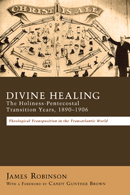James Robinson: Divine Healing
 James Robinson, Divine Healing: The Holiness-Pentecostal Transition Years, 1890-1906: Theological Transposition in the Transatlantic World (Eugene, OR: Pickwick Publications, 2013), 238 pages, ISBN 9781620324080.
James Robinson, Divine Healing: The Holiness-Pentecostal Transition Years, 1890-1906: Theological Transposition in the Transatlantic World (Eugene, OR: Pickwick Publications, 2013), 238 pages, ISBN 9781620324080.
James Robinson’s second volume in his Divine Healing series is a major contribution to the study of Pentecostal origins in the Anglo-American world. An interesting and highly researched work, Divine Healing: The Holiness-Pentecostal Transition Years, includes enough anecdotes and testimonies from primary sources to engage the lay reader and a tempered, even-handed review of the secondary literature and historical critiques others have had concerning the divine healing movement of the late 19th century and early 20th.
The author, (PhD Queen’s University, Belfast, 2001), is a relative newcomer to the field, having retired from a lifelong vocation as a grammar school teacher in Northern Ireland prior to his contributions to Pentecostal studies. His volumes include forewords by such noted Pentecostal scholars as Candy Gunther Brown (Indiana University) and William K. Kay (University of Chester). As a Presbyterian elder with Pentecostal roots, Robinson is conservative in regards to his work on divine healing: “A more subliminal, and possibly ethereal, aspiration is that some within the church of our day will find something in the book pertinent to the safeguard and furtherance of the historic ministry of healing” (Robinson 2011: Kindle Location 145). This hopeful conservatism underwrites both volumes and shines brilliantly through Robinson’s careful attention to detail and objectivity.
Transition focuses on the years between 1890-1906. His prior volume covers 1830-1890, and a planned volume will investigate 1906-1930. However, these dates are not tight restrictions, but, rather, a permeable focus on people and highlights of the proto-Pentecostal era building up to Azusa.
Transition begins with a brief overview of the preceding volume and establishes the parameters of the rest of the work. In the introduction, Robinson outlines three distinctive features of the radical healing apologetic that underwrote the flowering of the movement. These features were: 1) Redemption extended to “both the spirit and the body.” 2) “As salvation is through faith, so is healing,” and 3) “Medical intervention was considered the sign of a deficient faith and brought less glory to God” (Kindle locations 214-224). These features resurface time and time again in Robinson’s narrative and analysis. The rest of the Introduction links the Holiness-Pentecostal transition to earlier historical precedents and highlights divine healing teaching and practice in a variety of contexts.
Chapter 1 looks closely at the Holiness-Pentecostal transition in America. This transition occurred in the post-Bellum era and primarily among splinter groups off of the Methodist church. These splinter groups comprised the Wesleyan Holiness counter movement from which and in which radical divine healing advocates flourished. Again, Robinson underscores the connection between Holiness teaching and divine healing rooted in the extent of redemption. Following the trajectory from Methodism, through the Wesleyan Holiness counter movement, the author finishes out the chapter with how the Holiness movement with its divine healing overtones were linked to early Pentecostal movements and leaders such as Frank Sandford, the Shiloh Movement, Daniel Warner, and Alma White. These links, as elsewhere in the volume, are developed through extensive biography and narrative along with contemporaneous accounts from those outside the movement.
Category: Church History, Winter 2014


